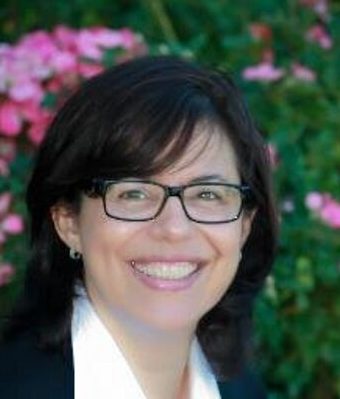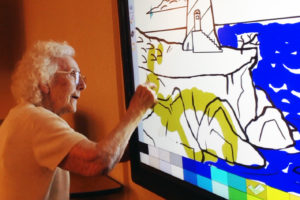Today SevenPonds shares part two of a two-part interview with Juliet Kerlin, research director at It’s Never 2 Late (IN2L), a Colorado-based company that builds senior-friendly computers for use in assisted living facilities and skilled nursing homes. (Read part one here.) IN2L is dedicated to making computers and adaptive technology accessible and enjoyable for older adults. Juliet explains how access to technology can engage and empower seniors.

Juliet Kerlin
Credit: twitter.com
Ellary: You have a really beautiful way of framing the IN2L technology as a tool to enhance interpersonal interaction. Is that how you explain it to the assisted living communities that use the program?
Juliet: Yes. Like any tool, the power of IN2L lies in people using it, understanding its benefits and coming together to make sure that it is going to be beneficial to the people they serve. It’s all about people and interpersonal interaction, and how technology can facilitate that.
One of the best things about these technologies is watching families connect using them. For example, at a memory care community in Minnesota, a family member mentioned that his mother loved “Oklahoma,” the musical. A staff member decided to play “Oklahoma” on the system while the family member was there. Even though the resident was really far along in her cognitive decline, she just came alive when she heard the music. And for her son to be able to see his mom like that, especially when he was already having a lot of problems connecting with her, was wonderful! It was so gratifying to see both of them smiling and to provide them the opportunity to connect.
Ellary: Why is it so important to provide personalized experiences for people undergoing cognitive decline?
Juliet: Because, especially for older adults, certain experiences can lead to a lot of anxiety. There may be a type of music that an individual doesn’t like, or a sort of activity that they don’t like, and trying to make someone participate in something they don’t enjoy can produce a lot of stress. For someone with dementia, who can’t communicate as readily, that can then lead to to the biocycle-social distress that people living with dementia often undergo. The point is to provide something that the person is going to appreciate, that they can get involved with — some way to take them back to who they are, to that experience of being themselves as they want to be seen. That’s extremely important for someone living with dementia.
Ellary: Can you give an example of this type of personal care?
Juliet: At an adult day center in Baton Rouge, Louisiana, one of the clients would experience biocycle social distress during the day and become very stressed and anxious. The staff didn’t really know how to address these issues, so they spoke with the family: Again it’s all about communication, learning more about the person to provide appropriate intervention. They found out that the client was Catholic and very spiritual. So one of the staff decided to play the rosary from the spiritual content on our system, which the resident loved. So that became what the staff used to calm him down and help him to re-engage and reintegrate into the group again.

Credit: seelio.com
Ellary: Wow, that’s lovely. So it sounds like the content on the IN2L system is broad and diversified enough to engage a wide range of personality types and interests.
Juliet: Yes, that’s the idea.
Ellary: Can you talk about some of the research done on the benefits of adaptive computer technology for senior citizens?
Juliet: Of course. The University of Washington published a study in 2014 looking at how IN2L could work for people with dementia living in memory care communities. It was a dyad case study looking at how family members could be involved in the implementation of adaptive computer technology. The researchers found that it helped the relationship between the residents and the family members as well between the family members and the staff.
More recently, LeadingAge Center for Aging Services Technologies released a study done at a community in Iowa, which had received a grant from the state to see if IN2L could reduce the use of antipsychotics in people living with dementia and improve their quality of life. The study showed that 50 percent fewer residents required antipsychotics by the end of the grant period, and there was a 20 percent reduction in the total number of “as needed” doses of antipsychotics given overall.
Even more recently, Westminster Canterbury on Chesapeake Bay completed a study that demonstrated a reduction in the use of antipsychotics for memory care residents after they introduced the IN2L system there. Stress indicators for the staff also dropped by 47 percent; depression among residents decreased by 41 percent, and cognitive and brain power scores increased for 23.5 percent of the residents in the intervention group.

Credit: in2l.com
Ellary: Wow! Those are impressive findings. Can you explain what the family portal is in the IN2L system?
Juliet: As I mentioned, you can personalize a user platform for each resident. Behind that user platform, you can upload content that’s already in the system to create a profile that that person truly loves. You can also upload videos and photographs to each person’s individual platform. That way the family is able to share experiences with the resident even if the person is bed-bound or rarely leaves the community.
Ellary: What is the Tell Your Story application?
Juliet: “My Story” is a wonderful application that allows family members, staff or volunteers to post photos and other information about an individual. The user answers a series of questions about the person, such as where they were born; how many brothers and sisters they have; who their kids are; their favorite hobbies; the accomplishments they’re most proud of; and things like that. It’s like creating a digital book –“Cliff Notes” of a person’s life. Some communities are using these stories to train new staff and bringing in volunteers to create the stories for their residents. It really helps the staff go from seeing the person as a patient to seeing the person as an individual. It creates a bond that I don’t think can happen otherwise.
Ellary: I’m curious about your spiritual content. You mentioned the rosary, and I’m wondering what else you have available under spirituality.
Juliet: We have spiritual music, such as hymns. We also partner with a pastor who has created wonderful spiritual videos. We have Bible stories, which can be a wonderful way for people to reminisce. We try to provide content for different faith groups, so we have Buddhism, Christianity, Islam, Judaism, Taoism, etc. We even have Bible trivia and other spiritual trivia. Trivia games are very popular with our residents.
Ellary: Are there any other companies that are offering this type of technology?

Credit: in2l.com
Juliet: None that are offering our particular technology, but there are companies that are coming into the market or have been around for a few years. Two that I know of are ConnectedLiving and Independa. There are also other companies that are seeing the value in providing technology for older adults, and that’s wonderful. The more options there are, the better it is.
Ellary: Well, thank you for being pioneers in this field! And thank you so much for taking the time to speak with SevenPonds!

 What Is Senior-friendly Technology And How Is It Beneficial For Older Adults? An Interview With Juliet Kerlin, Part Two
What Is Senior-friendly Technology And How Is It Beneficial For Older Adults? An Interview With Juliet Kerlin, Part Two


 Our Annual Seven Holiday Gifts for Someone Who Is Grieving, 2024 Edition
Our Annual Seven Holiday Gifts for Someone Who Is Grieving, 2024 Edition
 “Making Mobiles” by Karolina Merska
“Making Mobiles” by Karolina Merska
 “Hands Up to the Sky” by Michael Franti & Spearhead
“Hands Up to the Sky” by Michael Franti & Spearhead














